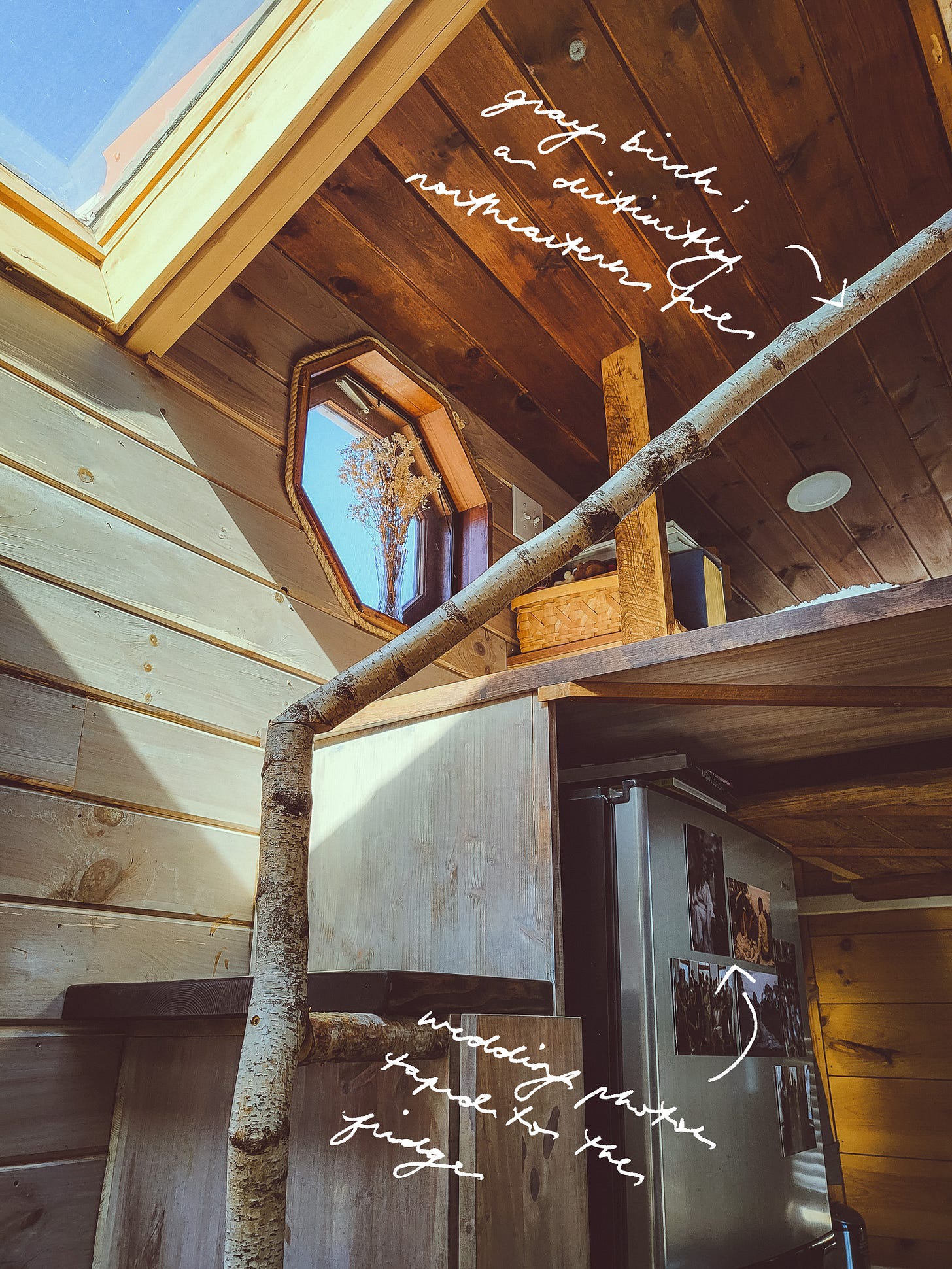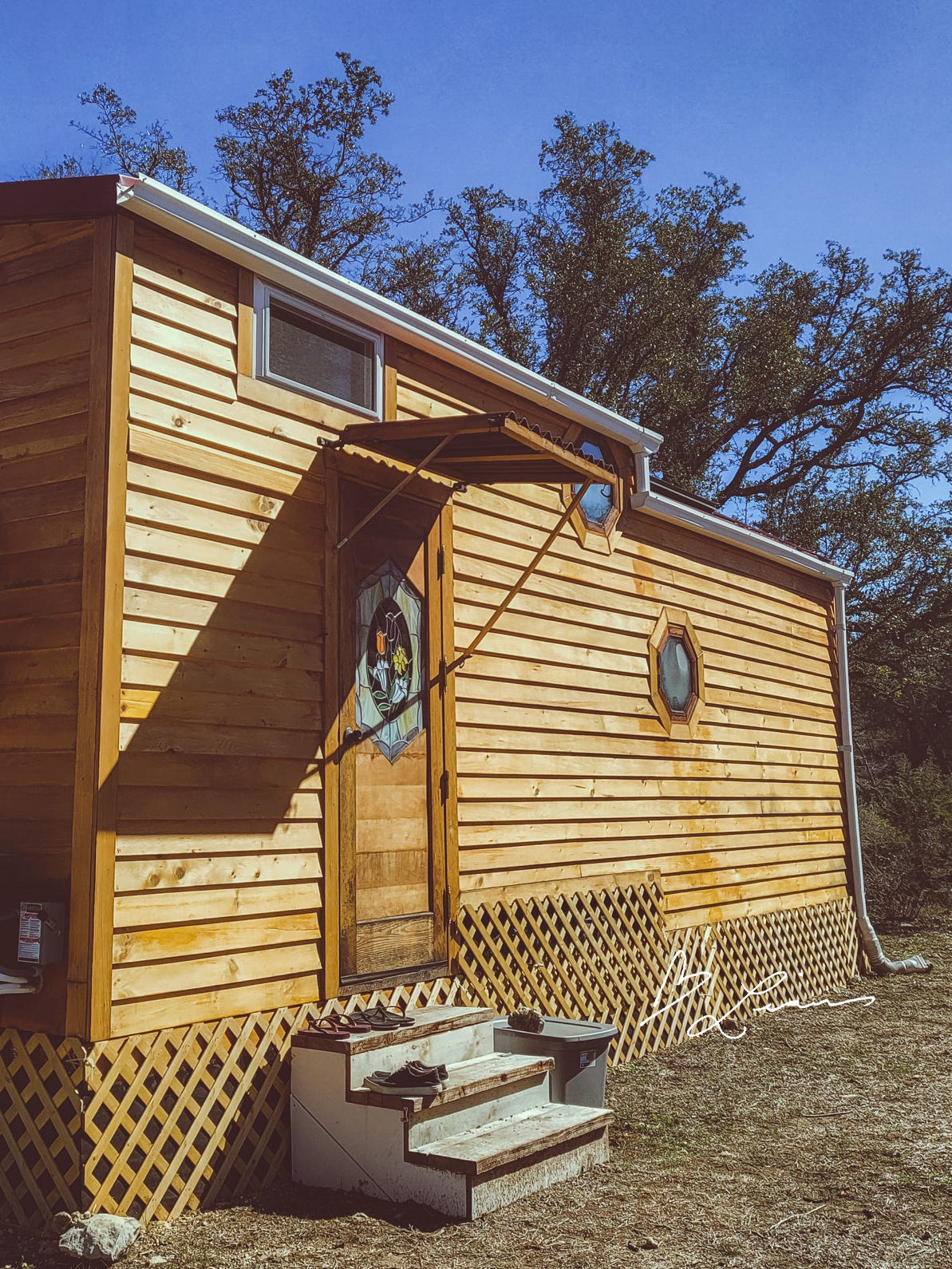Self-sufficiency doesn’t spring from isolation, but community
My life in a tiny home, six months in, part 3 of 3
A strange combination of pride, shame, and hyperindividualism once convinced me that independence meant doing everything on my own. I wanted to prove to myself that I could navigate the world purely on my own knowledge, capacities, and merits. Help, when offered, is denied or reluctantly and shamefully accepted. What I am unable to do myself, I put off until the hypothetical moment I will have spontaneously developed the ability to do so. This has resulted in missed opportunities for failure—for learning—and has not brought me any closer to the independence I badly desired.
Moving to a new country and pursuing an unexpected route confronted this belief. Decisions fueled by the conviction I’ll do it all myself kept stumbling into towering brick walls that felt like hilariously obvious signs that I, in fact, could not do it all myself.
The initial steps were not insurmountable, which, for a time, sustained the illusion that help was unnecessary. Questions I had about acquiring a tiny home—What permits must I file? Am I legally allowed to purchase a trailer as a non-resident? Where am I allowed to park the home? What does it mean to have a 30-amp power requirement? Are there insurance options for tiny homes on wheels?—were answered by extensive research, enabling me to successfully facilitate the purchase and transport of the home from Cossayuna, New York to Johnson City, Texas.
Setting up the home was another matter entirely; it seemed to sidestep all our preparations and outsmart my research capabilities. The how-to videos Michael and I watched were helpful to a certain extent, but we often encountered considerations that we did not even know to think about. When the tiny home was delivered, the driver asked us how we wanted to orient the home. We hadn’t planned that out as we didn’t imagine it would matter (though, of course, it did). For privacy, I wanted our large window to point away from our neighbor, which in our setup meant facing either South or East. The final verdict, informed by both preference and local advice, was to have the window facing East, to avoid the blistering afternoon sun, and the tongue of the trailer facing South, where strong gusts often came from.
As we were about to connect to the power source, our landlord Carl pointed out our 100-ft power cord, which had to be coiled due to its length, was a fire hazard, especially in very dry conditions. None of the setup guides online mentioned anything about that, likely because it must be so obvious to anyone with a basic understanding of electricity, which, embarrassingly, we lacked. In shopping for a shorter cord, we discovered that there were different plug types for 30-amp cords, and we didn’t know which one we needed. We later learned that there are two main types for RVs—either the TT-30 or the L5-30—and our inlet required the one with a twist lock mechanism.
The second-hand tiny home, having traveled almost 2,000 miles in three days, continued to reveal flaws as we settled in: loosened screws, faulty or incomplete caulking, missing exterior planks, an unsealed door, slow drainage. Objectively, these issues are simple enough to remedy, but having no prior experience with home maintenance, I was overwhelmed. It was with the help of Michael’s grandfather Gary, who is a painter, woodworker, and avid naturalist, that we learned how to do basic repairs. On several occasions, he accompanied us to the hardware store to advise us on the right materials to buy, and when he wasn’t around, Michael would call him for a quick consult. From him, I learned how to use a level, a palm sander, and a power saw. In what felt like inheriting an heirloom, Gary gave us a handful of spiral nails that once belonged to his grandfather; these nails now hold down many of the exterior planks of the house.
Completion of our home improvement project relied on equipment like a step ladder and a staple gun that Carl generously lent us. In return, we’d occasionally help with work around the ranch, like feeding his Great Pyrenees watchdogs, repainting the old chicken coop, and planting a Shumard oak in his front yard. Once, Michael even helped put out a small fire that, due to unexpected wind, strayed from the year’s burn pile.
More recently, when the freezing storm in early February encased our car in thick ice, our new neighbor John came out of his motorhome to hand us an ice scraper and assist in defrosting our car, which, apparently, has built-in features for this kind of weather. Born and raised in a ski town in Colorado, John wasn’t fazed by the icy weather that posed a danger to many Texans unaccustomed to the bitter cold. He was barefoot and dressed in sweatpants and a Patagonia hoodie while I was convinced that my toes, protected by two layers of socks and my leather shoes, were falling off.
In many matters of homemaking, Michael’s grandmother Victoria is our lighthouse. Much of my literacy in the kitchen was nurtured during visits to her and Gary’s lakeside house. Her instincts in the kitchen, refined from a decade-long career managing the reception room for the lieutenant-governor at the Texas Capitol, are impeccable. Even just watching her work taught me basic etiquette and techniques for efficient cooking. From her I learned how to make sourdough bread, the secret to making good soup, the best way to cook black beans, and proper knife techniques. Between Michael and I, he is better at composing a crisp, well-balanced salad, a skill he, too, learned from his grandmother.
Wisdom and kindness from countless people buoyed, enveloped, and guided Michael and I through this pivotal point in our lives. Our home is alive with it. Crystals gifted by my brother and his partner—who is my sister in all but name—sit on the windowsill of our bathroom, away from direct sunlight. Michael’s brother, who flew from the Philippines with his son to attend our wedding last September, gave us a small parol which now illuminates our home with a festive spirit year-round. From my sister, too many gifts to count: candles, books, our cast-iron pan, treasured knickknacks. From my and Michael’s parents, the support and concern that gave us the courage to pursue a life on our own terms. Beyond those that I can name, the strangers whom many of our possessions once belonged to bestow invisible but palpable character to the space: the kitchenware from various antique stores, the pillows on our daybed, the hand-me-downs and thrifted clothes. Even the house itself, previously owned by a Connecticut-based reiki practitioner, was built from reclaimed wood with unimaginable past lives. Her design choices—the octagonal windows bordered with Manila rope, the geometric protrusion of one wall, the birch wood railing, the cobalt blue paint—frame our daily experience inside the home.
To some this may seem like common sense, but it was revelatory to acknowledge that reliance on other people didn’t necessarily result in unhealthy dependencies, although I imagine it can. Instead, in remaining curious and attentive, I gained glimmers of confidence to do trial-and-error myself. As someone who solves most problems by scouring obscure online forums for an easy answer distilled from a stranger’s years of experience, unlearning the frustration with doing trial-and-error myself is the hardest part about becoming more self-sufficient. It is also the most liberating. Culinary principles I’ve learned from Victoria and the many creators who share their expertise on the internet have equipped me with the tools to experiment in my own kitchen. Gary’s countless lessons on local botany, woodworking, and home maintenance guide Michael and I every time we envision changes or improvements to our space. When their garden is abundant with Swiss chard or basil, they allow us a share of their harvest, a generous gesture that inspires me to start my own garden one day. Doing basic ranch work for Carl and constantly improving the house for each other has eased me into trusting my body a lot more than I used to, and introduced me to whole new skillset. Mistakes, naturally, were made: purchasing the wrong wood stain or deck nails, soaping my cast-iron pan, scorching the bottom of my loaf, neglecting to insulate our water source, forgetting to scrape off chipped paint before brushing it over with a fresh coat. It is in having learned from these, with the counsel of friends, family, acquaintances, that future uncertainties worry me a lot less.
Where Michael and I live isn’t even on the map. When we found the posting for the lot we are renting back in July, it warned of black widows, snakes, and mountain lions, but also claimed quiet, starry nights; unrivalled privacy. Excited, we signed the lease before we even saw the house in person. Throughout the process, despite our youthful enthusiasm, there was also so much doubt about our drastic choices, the simultaneous leaps of faith into spaces we knew so little about. Fortune, thankfully, was on our side in the form of community. Despite living in a tiny house on this lovely nowhere, there is no loneliness. There is very little fear. Knowing now how and when to turn to others, I have never felt more independent.











I love this one Lian. I loved the others too but this one really brought me so much closer to what you and Michaela must have been experiencing... for some reason. Thank you for sharing. And I am so glad you have such a wonderful community/family around you and Michael.